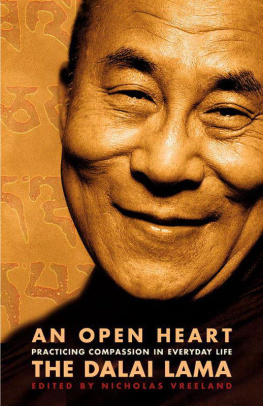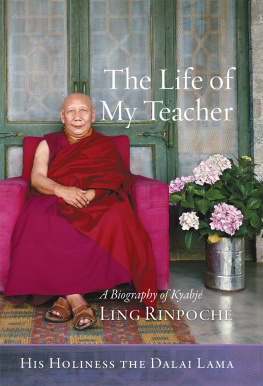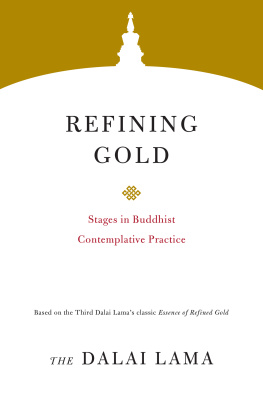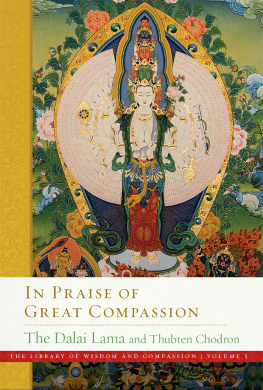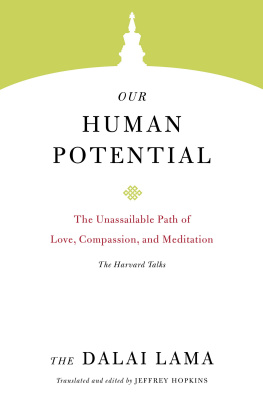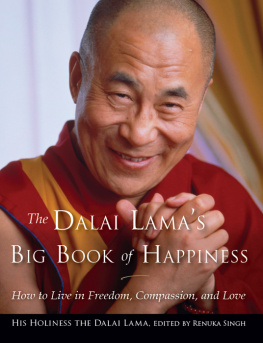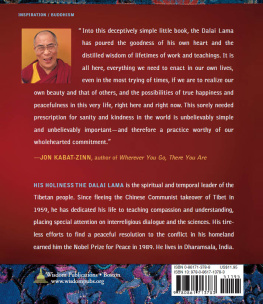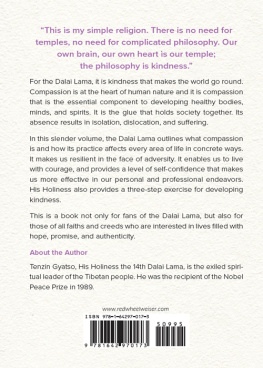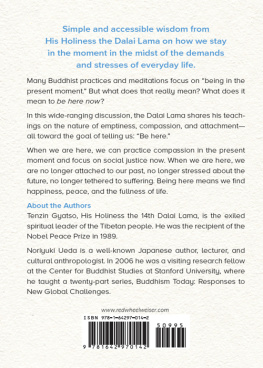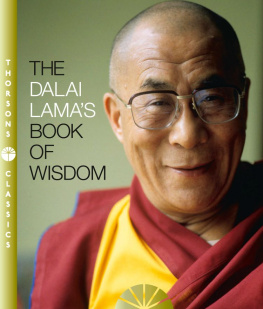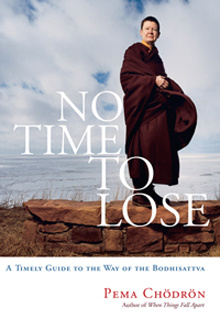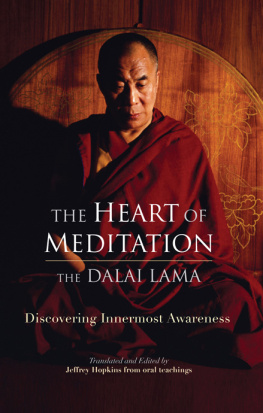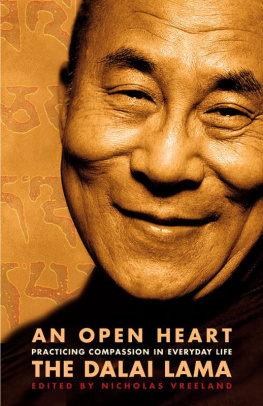Copyright 2001 by His Holiness The Dalai Lama
Foreword copyright 2001 by Nicholas Vreeland
Afterword copyright 2001 by Khyongla Rato and Richard Gere
All rights reserved. No part of this book may be reproduced in any form or by any electronic or mechanical means, including information storage and retrieval systems, without permission in writing from the publisher, except by a reviewer who may quote brief passages in a review.
Little, Brown and Company
Hachette Book Group
237 Park Avenue
New York, NY 10017
Visit our Web site at www.HachetteBookGroup.com
The Little, Brown and Company name and logo are registered trademarks of Hachette Book Group
First eBook Edition: November 2008
ISBN: 978-0-316-04583-4
Contents
BY NICHOLAS VREELAND

IN BUDDHISM COMPASSION is defined as the wish that all beings be free of their suffering. Unfortunately, it is not possible for us to rid the world of its misery. We cannot take the task upon ourselves, and there is no magic wand to transform affliction into happiness. Yet we can develop our own minds in virtue and thereby help others to do the same.
In August 1999 His Holiness the Dalai Lama was invited by The Tibet Center and The Gere Foundation to give a series of talks in New York City. This book is drawn from those talks. In the following pages His Holiness the Dalai Lama shows how we can open our hearts and develop true and lasting compassion toward all beings. His Holinesss entire life has been a testament to the power of open-heartedness. His own spiritual training began when he was just a child. Upon being recognized as the reincarnation of the thirteenth Dalai Lama at the age of two, he was taken from his home in northeastern Tibet to the Tibetan capital of Lhasa. He assumed temporal rule of Tibet at sixteen and was forced to put his beliefs in nonviolence and tolerance to the most extreme of tests as the Communist Chinese army brutally invaded his country. He did his best to protect his people and keep his aggressors at bay while also pursuing his studies and his practice of the Buddhas path to salvation.
In 1959, as the Chinese Communist forces prepared to bomb his summer palace, the twenty-five-year-old Dalai Lama fled his country. More than 100,000 Tibetans followed him. Living in India and throughout the world, they now devote themselves to an extraordinary nonviolent campaign for Tibetan freedom. From the Indian town of Dharamsala, nestled in the foothills of the Himalaya, His Holiness has established a democratic government to serve his people those still in Tibet, the great number who live in Indian refugee settlements, and those in other countries. His Holiness has worked hard to preserve all aspects of Tibetan culture, but at the center of his efforts is Tibets spiritual tradition, for in Tibet, spirituality and culture are inseparable. He has maintained his own practice of study, contemplation, and meditation and has tirelessly taught the Buddhist path to people throughout the world. He has devoted great effort to the reestablishment of monasteries, nunneries, and their traditional curricula of study and practice, all in the service of keeping alive the way of understanding outlined by Buddhisms founder, Shakyamuni Buddha.
The story of Buddhisms birth is familiar to many. In the fifth century B.C., Prince Shakyamuni led a privileged life in his fathers kingdom in what is now Nepal. While still a young man, Shakyamuni came to recognize the pointlessness of his comfortable life. Witnessing old age, illness, and death among his people, he began to see through the deceptive veils of comfort and worldly happiness. One night the recently married prince left his palace, as well as his wife and young son. He cut off his hair with his sword and set off into the jungle in pursuit of freedom from the worldly life and the miseries that he now understood were inextricably associated with it.
The young renunciate soon came across five ascetics, with whom he spent many years practicing strict meditation and other austerities. But ultimately he realized that this was not bringing him any closer to his goal of wisdom and enlightenment, so he left his companions behind. Having broken with their severe ways, he now decided to devote himself to a search for ultimate truth. He sat beneath the Bodhi Tree, vowing not to move until he had attained this goal of final realization. After much perseverance, Prince Shakyamuni was successful. He saw the true way all phenomena exist and thereby attained the fully enlightened and omniscient state of a Buddha.
Shakyamuni Buddha rose from his meditation and wandered through northern India until he once again encountered his five ascetic companions. They were initially determined not to acknowledge his presence, as they believed that he had renounced their true spiritual way. However, the glow of his enlightened state so affected them that they beseeched him to share his discovery. The Buddha then propounded the Four Noble Truths: the truth of suffering, its origin, the possibility of its cessation, and the path leading to that cessation. The Buddha showed the true nature of our miserable state. He taught the causes that bring about this situation. He established the existence of a state in which our suffering and its causes come to an end, and then taught the method by which to achieve this state.
While in New York City, His Holiness the Dalai Lama gave three days of teachings at the Beacon Theatre. The subject of these talks centered on the Buddhist methods by which one achieves ultimate enlightenment. He wove together the contents of two texts, the Middle-Length Stages of Meditation by the eighth-century Indian master Kamalashila and The Thirty-Seven Practices of Bodhisattvas by the fourteenth-century Tibetan practitioner Togmay Sangpo.
Stages of Meditation was composed when the thirty-third Tibetan king, Trisong Detsen, invited its Indian author to Tibet in order to defend the analytical approach to Buddhist practice favored in the great Indian monastic universities of Nalanda and Vikramalasila. This form of Buddhism, introduced into Tibet by Kamalashilas master, Shantarakshita, was being challenged by Hashang, a Chinese monk propounding a view that discouraged any mental activity. In order to establish which form of Buddhism would be followed in Tibet, a debate was held before the king. In the debate between Kamalashila and Hashang, Kamalashila was able to irrefutably establish the importance of mental reasoning in spiritual development and was thereby proclaimed the winner. To commemorate his victory, the king requested that he compose a text establishing his position. He wrote a long, a medium, and a short form of Stages of Meditation.
Kamalashilas text outlines clearly and concisely what have been called the vast and profound stages of the path to highest enlightenment. Though often overlooked in Tibet, the book has immense value, and His Holiness has devoted much effort to bring it to the world beyond.
The second text, The Thirty-Seven Practices of Bodhisattvas, is a concise and clear description of how to live a life dedicated to others. Its author, Togmay Sangpo, inspires us to change our habitual selfish tendencies and to instead act in recognition of our dependence upon our fellow beings. Togmay Sangpo himself led the life of a simple monk, selflessly devoting himself to others through the practice of opening his heart to love and compassion.
Throughout these talks, translator Geshe Thubten Jinpa admirably expressed the subtle aspects of Buddhist philosophy taught by His Holiness while also conveying the loving humor always present in his teachings.
Next page
